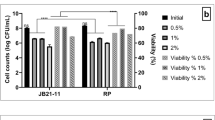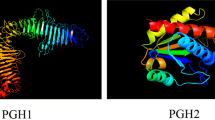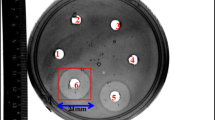Abstract
Lactic acid bacteria (LAB) are economically important because of their fermentative aptitude and they also confer health and nutritional benefits. Pediococcus acidilactici NCDC 252 (NCDC 252) is potential probiotic with novel genome that exhibited all in-vitro probiotic attributes, colonization in intestine and survival in conditions that mimick gastric, intestinal and vaginal fluid. Genome was screened for its ability to produce antimicrobial peptide (AMP). AMP from NCDC 252 was isolated and purified against indicator strain (Escherichia coli). AMP production was optimized in MRS broth at 32 °C, pH 6 and upto 36 h of incubation under both aerobic and anaerobic conditions. AMP was purified 2.2 fold with yield of 7.2% and specific activity of 64.5 U mg/mL using ammonium sulphate precipitation (upto 70%) and gel filtration chromatography. Molecular weight of purified AMP was calculated to be 2.5 KDa. Tricine SDS-PAGE and LC/MS studies confirmed it to be a low molecular weight peptide. AMP was stable over pH range of 3 to 9 and temperature range of 40 °C to 100 °C. Enzymatic treatment inactivated the AMP whereas, detergent treatment enhanced its activity. Biopreservation potential of purified AMP and whole NCDC 252 cells was studied by incubating them with some dairy products, apple juice, apricot pulp and pre-pasteurized wine over 72 h. Bacterial growth in AMP treated food products reduced significantly after 72 h. Viable cell count decreased to approximately half in both purified AMP treated and NCDC 252 treated food products. Purified AMP demonstrated exceptional resistance to heat treatment over a wide pH range, enabling it to establish itself as a biopreservative. Studies on biopreservation potential revealed NCDC 252 derived AMP to be effective even at low concentrations and it can be utilised to extend the shelf life of food goods.























Similar content being viewed by others
References
Amorim Franco TM, Blanchard JS (2017) Bacterial branched-chain amino acid biosynthesis: structures, mechanisms, and drugability. Biochemistry 56(44):5849–5865
Anastasiadou S, Papagianni M, Ambrosiadis I, Koidis P (2008) Rapid quantifiable assessment of nutritional parameters influencing pediocin production by Pediococcus acidilactici NRRL B5627. Bioresour Technol 99(14):6646–6650
Attri P, Jodha D, Gandhi D, Dhanda S (2012) Screening of intracellular, extracellular and membrane bound exopeptidases in lactic acid bacteria (LAB). Milchwissenschaft 67(4):421–424
Attri P, Jodha D, Gandhi D, Chanalia P, Dhanda S (2015a) In vitro evaluation of Pediococcus acidilactici NCDC 252 for its probiotic attributes. Int J Dairy Technol 68(4):533–542
Attri P, Khaket TP, Jodha D, Singh J, Dhanda S (2015b) Biochemical, kinetic, and in silico characterization of DING protein purified from probiotic lactic acid bacteria Pediococcus acidilactici NCDC 252. Appl Biochem Biotechnol 175(2):1092–1110
Balciunas EM, Martinez FAC, Todorov SD, de Melo Franco BDG, Converti A, de Souza Oliveira RP (2013) Novel biotechnological applications of bacteriocins: a review. Food Control 32(1):134–142
Bansal P, Kumar R, Singh J, Dhanda S (2019) Next generation sequencing, biochemical characterization, metabolic pathway analysis of novel probiotic Pediococcus acidilactici NCDC 252 and it’s evolutionary relationship with other lactic acid bacteria. Mol Biol Rep 46(6):5883–5895
Bansal P, Kumar R, Singh J, Dhanda S (2020) In silico analysis of Pediococcus acidilactici NCDC 252 genome revealed nineteen novel genes. Gene Rep 21:100849
Bauer R, Dicks LMT (2005) Mode of action of lipid II-targeting lantibiotics. Int J Food Microbiol 101(2):201–216
Baumann K, Adelantado N, Lang C, Mattanovich D, Ferrer P (2011) Protein trafficking, ergosterol biosynthesis and membrane physics impact recombinant protein secretion in Pichiapastoris. Microb Cell Fact 10(1):1–15
Cavicchioli VQ (2018) Characterization of bacteriocinogenic Enterococcus hirae and Pediococcus pentosaceus isolated from artisanal cheese and their bacteriocins
Chanalia P, Gandhi D, Attri P, Dhanda S (2018) Purification and characterization of β-galactosidase from probiotic Pediococcus acidilactici and its use in milk lactose hydrolysis and galactooligosaccharide synthesis. Bioorg Chem 77:176–189
Cheigh CI, Choi HJ, Park H, Kim SB, Kook MC, Kim TS, Pyun YR (2002) Influence of growth conditions on the production of a nisin-like bacteriocin by Lactococcus lactis subsp. lactis A164 isolated from kimchi. J Biotechnol 95(3):225–235
Chikindas ML, Weeks R, Drider D, Chistyakov VA, Dicks LM (2018) Functions and emerging applications of bacteriocins. Curr Opin Biotechnol 49:23–28
Choi HJ, Cheigh CI, Kim SB, Pyun YR (2000) Production of a nisin-like bacteriocin by Lactococcus lactis subsp. lactis A164 isolated from Kimchi. J Appl Microbiol 88(4):563–571
Cotter PD, Ross RP, Hill C (2013) Bacteriocins—a viable alternative to antibiotics? Nat Rev Microbiol 11(2):95
De Giani A, Bovio F, Forcella M, Fusi P, Sello G, Di Gennaro P (2019) Identification of a bacteriocin-like compound from Lactobacillus plantarum with antimicrobial activity and effects on normal and cancerogenic human intestinal cells. AMB Express 9(1):1–11
De la Salud Bea R, Petraglia AF, Ascuitto MR, Buck QM (2017) Antibacterial activity and toxicity of analogs of scorpion venom IsCT peptides. Antibiotics 6(3):13
Dedeh K, Ray B (2000) Isolation and characterization of warnerin 20, a bacteriocin produced by Staphylococcus warneri FM20. Indian J Microbiol 40(1):41–47
Deraz SF, Karlsson EN, Khalil AA, Mattiasson B (2007) Mode of action of acidocin D20079, a bacteriocin produced by the potential probiotic strain, Lactobacillus acidophilus DSM 20079. J Ind Microbiol Biotechnol 34(5):373–379
Deshmukh PV, Thorat PR (2014) Detection of antimicrobial efficacy of novel bacteriocin produced from Lactobacillus similis RL7. Int J Adv Res 2(1):987–995
Dhanda S, Kumar P, Choudhary M, Dhanda S (2021) In vitro studies on anti-inflammatory, antioxidant and antihyperglycemic activities of potential probiotic Pediococcus acidilactici NCDC 252. Res J Biotechnol. https://doi.org/10.25303/1612rjbt1823
Dimitrijevic NM, Rozhkova E, Rajh T (2009) Dynamics of localized charges in dopamine-modified TiO2 and their effect on the formation of reactive oxygen species. J Am Chem Soc 131(8):2893–2899
Fujita S, Abe T, Drummond MJ, Cadenas JG, Dreyer HC, Sato Y, Rasmussen BB (2007) Blood flow restriction during low-intensity resistance exercise increases S6K1 phosphorylation and muscle protein synthesis. J Appl Physiol 103(3):903–910
Furtado MB, Costa MW, Pranoto EA, Salimova E, Pinto AR, Lam NT, Rosenthal NA (2014) Cardiogenic genes expressed in cardiac fibroblasts contribute to heart development and repair. Circ Res 114(9):1422–1434
Galvez A, Abriouel H, López RL, Omar NB (2007) Bacteriocin-based strategies for food biopreservation. Int J Food Microbiol 120(1–2):51–70
Gandhi D, Chanalia P, Attri P, Dhanda S (2016) Dipeptidyl peptidase-II from probiotic Pediococcus acidilactici: purification and functional characterization. Int J Biol Macromol 93:919–932
Garg N, Kaur B (2015) Biopreservation potential and stability assessment of Pediococcus acidilactici BA28. Int J Adv Res 3(9):980–989
Ge J, Sun Y, Xin X, Wang Y, Ping W (2016) Purification and partial characterization of a novel bacteriocin synthesized by Lactobacillus paracasei HD1-7 isolated from Chinese sauerkraut juice. Sci Rep 6(1):1–7
Georgalaki MD, Van den Berghe E, Kritikos D, Devreese B, Van Beeumen J, Kalantzopoulos G, Tsakalidou E (2002) Macedocin, a food-grade lantibiotic produced by Streptococcus macedonicus ACA-DC 198. Appl Environ Microbiol 68(12):5891–5903
Gharsallaoui A, Oulahal N, Joly C, Degraeve P (2016) Nisin as a food preservative: part 1: physicochemical properties, antimicrobial activity, and main uses. Crit Rev Food Sci Nutr 56(8):1262–1274
Ghosh B, Sukumar G, Ghosh AR (2019) Purification and characterization of pediocin from probiotic Pediococcus pentosaceus GS4, MTCC 12683. Folia Microbiol 64(6):765–778
Goyal C, Malik RK, Pradhan D (2018) Purification and characterization of a broad spectrum bacteriocin produced by a selected Lactococcus lactis strain 63 isolated from Indian dairy products. J Food Sci Technol 55(9):3683–3692
Gross E, Morell JL (1971) Structure of nisin. J Am Chem Soc 93(18):4634–4635
Guerra NP, Pastrana L (2002) Nisin and pediocin production on mussel-processing waste supplemented with glucose and five nitrogen sources. Lett Appl Microbiol 34(2):114–118
Jiménez-Díaz R, Rios-Sanchez RM, Desmazeaud M, Ruiz-Barba JL, Piard JC (1993) Plantaricins S and T, two new bacteriocins produced by Lactobacillus plantarum LPCO10 isolated from a green olive fermentation. Appl Environ Microbiol 59(5):1416–1424
Johnson MK (1992) MEM: mechanisms of recollection. J Cogn Neurosci 4(3):268–280
Kondrotiene K, Kasnauskyte N, Serniene L, Gölz G, Alter T, Kaskoniene V, Malakauskas M (2018) Characterization and application of newly isolated nisin producing Lactococcus lactis strains for control of Listeria monocytogenes growth in fresh cheese. LWT 87:507–514
Krivorotova T, Staneviciene R, Luksa J, Serviene E, Sereikaite J (2016) Preparation and characterization of nisin-loaded pectin-inulin particles as antimicrobials. LWT-Food Sci Technol 72:518–524
Kumar R, Bansal P, Singh J, Dhanda S, Bhardwaj JK (2019) Aggregation, adhesion and efficacy studies of probiotic candidate Pediococcus acidilactici NCDC 252: a strain of dairy origin. World J Microbiol Biotechnol 36(1):1–15
Kumar R, Bansal P, Singh J, Dhanda S (2020) Purification, partial structural characterization and health benefits of exopolysaccharides from potential probiotic Pediococcus acidilactici NCDC 252. Process Biochem 99:79–86
Lade HS, Chitanand MP, Gyananath G, Kadam TA (2006) Studies on some properties of bacteriocins produced by Lactobacillus species isolated from agro-based waste. Int J Microbiol 2(1):1–5
Lee NK, Paik HD (2001) Partial characterization of lacticin NK24, a newly identified bacteriocin of Lactococcus lactis NK24 isolated from Jeot-gal. Food Microbiol 18(1):17–24
Li W, Separovic F, O’Brien-Simpson NM, Wade JD (2021) Chemically modified and conjugated antimicrobial peptides against superbugs. Chem Soc Rev 50(8):4932–4973
Liu W, Hansen JN (1990) Some chemical and physical properties of nisin, a small-protein antibiotic produced by Lactococcuslactis. Appl Environ Microbiol 56(8):2551–2558
Malheiros PS, Sant’Anna V, Todorov SD, Franco BD (2015) Optimization of growth and bacteriocin production by Lactobacillus sakei subsp sakei 2a. Braz J Microbiol 46(3):825–834
Maria M, Janakiraman S (2012) Detection of heat stable bacteriocin from Lactobacillus acidophilus NCIM5426 by liquid chromatography/mass spectrometry. Indian J Sci Technol 5(3):2325–2332
Mokoena MP, Mutanda T, Olaniran AO (2016) Perspectives on the probiotic potential of lactic acid bacteria from African traditional fermented foods and beverages. Food Nutr Res 60(1):29630
Moreno MRF, Leisner JJ, Tee LK, Ley C, Radu S, Rusul G, De Vuyst L (2002) Microbial analysis of Malaysian tempeh, and characterization of two bacteriocins produced by isolates of Enterococcus faecium. J Appl Microbiol 92(1):147–157
Motlagh AM, Bhunia AK, Szostek F, Hansen TR, Johnson MC, Ray B (1992) Nucleotide and amino acid sequence of pap-gene (pediocin AcH production) in Pediococcus acidilactici H. Lett Appl Microbiol 15(2):45–48
Neher A, Arnitz R, Gstöttner M, Schäfer D, Kröss EM, Nagl M (2008) Antimicrobial activity of dexamethasone and its combination with N-chlorotaurine. Arch Otolaryngol-Head Neck Surg 134(6):615–620
Oumer A, Gaya P, Fernandez-garcia E, Mariaca R, Garde S, Medina M, Nunez M (2001) Proteolysis and formation of volatile compounds in cheese manufactured with a bacteriocin-producing adjunct culture. J Dairy Res 68(1):117
Papagianni M, Anastasiadou S (2009) Pediocins: the bacteriocins of Pediococci. Sources, production, properties and applications. Microb Cell Factor 8(1):1–16
Perez RH, Zendo T, Sonomoto K (2014) Novel bacteriocins from lactic acid bacteria (LAB): various structures and applications. Microb Cell Fact 13(1):1–13
Porto WF, Pires ÁS, Franco OL (2017) Antimicrobial activity predictors benchmarking analysis using shuffled and designed synthetic peptides. J Theor Biol 426:96–103
Randjelovic P, Veljkovic S, Stojiljkovic N, Sokolovic D, Ilic I (2017) Gentamicin nephrotoxicity in animals: current knowledge and future perspectives. EXCLI J 16:388
Rao L, Wang Y, Chen F, Liao X (2016) The synergistic effect of high pressure CO2 and nisin on inactivation of Bacillus subtilis spores in aqueous solutions. Front Microbiol 7:1507
Ray B, Miller KW (2000) Natural food antimicrobial systems. In: Naidu AS (ed) Pediocins of Pediococcus species. CRC Press, Boca Raton, pp. 525–566
Ribeiro SC, O’Connor PM, Ross RP, Stanton C, Silva CC (2016) An anti-listerial Lactococcus lactis strain isolated from Azorean Pico cheese produces lacticin 481. Int Dairy J 63:18–28
Saad MA, Abdelsamei HM, Ibrahim E, Abdou AM, El Sohaimy SA (2015) Effect of pH, heat treatments and proteinase K enzyme on the activity of Lactobacillus acidophilus bacteriocin. Benha Vet Med J 28(1):210–215
Salgado JM, Abrunhosa L, Venâncio A, Domínguez JM, Belo I (2015) Enhancing the bioconversion of winery and olive mill waste mixtures into lignocellulolytic enzymes and animal feed by Aspergillus uvarum using a packed-bed bioreactor. J Agric Food Chem 63(42):9306–9314
Schägger H (2006) Tricine–sds-page. Nat Protoc 1(1):16
Sharma N, Kapoor R, Gautam N, Kumari R (2011) Purification and characterization of bacteriocin produced by Bacillus subtilis R75 isolated from fermented chunks of mung bean (Phaseolus radiatus). Food Technol Biotechnol 49(2):169
Sharma G, Sharma S, Kumar A, Ala’a H, Naushad M, Ghfar AA, Stadler FJ (2018) Guar gum and its composites as potential materials for diverse applications: a review. Carbohydr Polym 199:534–545
Shi Y, Mowery RA, Ashley J, Hentz M, Ramirez AJ, Bilgicer B, Slunt-Brown H, Borchelt DR, Shaw BF (2012) Abnormal SDS-PAGE migration of cytosolic proteins can identify domains and mechanisms that control surfactant binding. Protein Sci 21(8):1197–1209
Shin JH, Park SH, Oh YH, Choi JW, Lee MH, Cho JS, Jeong KJ, Joo JC, Yu J, Park SJ, Lee SY (2016) Metabolic engineering of Corynebacterium glutamicum for enhanced production of 5-aminovaleric acid. Microb Cell Fact 15(1):1–3
Simova ED, Beshkova DB, Dimitrov ZP (2009) Characterization and antimicrobial spectrum of bacteriocins produced by lactic acid bacteria isolated from traditional Bulgarian dairy products. J Appl Microbiol 106(2):692–701
Singh PK, Sharma S, Kumari A, Korpole S (2014) A non-pediocin low molecular weight antimicrobial peptide produced by Pediococcus pentosaceus strain IE-3 shows increased activity under reducing environment. BMC Microbiol 14(1):1–9
Skariyachan S, Govindarajan S (2019) Biopreservation potential of antimicrobial protein producing Pediococcus spp. towards selected food samples in comparison with chemical preservatives. Int J Food Microbiol 291:189–196
Sweis IE, Cressey BC (2018) Potential role of the common food additive manufactured citric acid in eliciting significant inflammatory reactions contributing to serious disease states: a series of four case reports. Toxicol Rep 5:808–812
Tafreshi SYH, Mirdamadi S, Norouzian D, Khatami S, Sardari S (2010) Effect of non-nutritional factors on nisin production. Afr J Biotechnol. https://doi.org/10.5897/AJB10.1409
Tagg J, McGiven A (1971) Assay system for bacteriocins. Appl Microbiol 21(5):943
Tanianskii DA, Jarzebska N, Birkenfeld AL, O’Sullivan JF, Rodionov RN (2019) Beta-aminoisobutyric acid as a novel regulator of carbohydrate and lipid metabolism. Nutrients 11(3):524
Theuretzbacher U, Bush K, Harbarth S, Paul M, Rex JH, Tacconelli E, Thwaites GE (2020) Critical analysis of antibacterial agents in clinical development. Nat Rev Microbiol 18(5):286–298
Thomas LV, Delves-Broughton J (2001) New advances in the application of the food preservative nisin. Danisco A/S, Copenhagen
Todorov SD, Holzapfel WH, Nero LA (2021) Safety evaluation and bacteriocinogenic potential of Pediococcus acidilactici strains isolated from artisanal cheeses. LWT 139:110550
William TS (2010) Amino acids, peptides and proteins. Compr Nat Prod II 5:121–148
Zamfir M, Stefan IR, Stancu MM, Grosu-Tudor SS (2016) Production, mode of action and sequencing of the corresponding gene of a bacteriocin produced by Lactococcuslactis 19.3. Int J Food Sci Technol 51(10):2164–2170
Zhao X, Wu H, Lu H, Li G, Huang Q (2013) LAMP: a database linking antimicrobial peptides. PLoS ONE 8(6):e66557
Zhu X, Zhao Y, Sun Y, Gu Q (2014) Purification and characterisation of plantaricin ZJ008, a novel bacteriocin against Staphylococcus spp. from Lactobacillus plantarum ZJ008. Food Chem 165:216–223
Zou H, Chen N, Shi M, Xian M, Song Y, Liu J (2016) The metabolism and biotechnological application of betaine in microorganism. Appl Microbiol Biotechnol 100(9):3865–3876
Acknowledgements
Authors are thankful to Kurukshetra University, Kurukshetra for providing necessary facilities. Authors also acknowledge Professor Brajesh Sawhney, Department of English and Dean, Faculty of Languages for editing manuscript for English language.
Author information
Authors and Affiliations
Contributions
SD, PB and PK: methodology and writing, SD: data curation, visualization, conceptualization, writing-reviewing and editing of original draft preparation. JS: editing in revised manuscript.
Corresponding author
Ethics declarations
Conflict of interest
There is no conflict of interest amongst the authors.
Additional information
Publisher's Note
Springer Nature remains neutral with regard to jurisdictional claims in published maps and institutional affiliations.
Supplementary Information
Below is the link to the electronic supplementary material.
Rights and permissions
Springer Nature or its licensor (e.g. a society or other partner) holds exclusive rights to this article under a publishing agreement with the author(s) or other rightsholder(s); author self-archiving of the accepted manuscript version of this article is solely governed by the terms of such publishing agreement and applicable law.
About this article
Cite this article
Dhanda, S., Kumar, P., Bansal, P. et al. Identification, Purification, Characterization and Biopreservation Potential of Antimicrobial Peptide of Pediococcus acidilactici NCDC 252. Int J Pept Res Ther 29, 15 (2023). https://doi.org/10.1007/s10989-022-10485-z
Accepted:
Published:
DOI: https://doi.org/10.1007/s10989-022-10485-z




